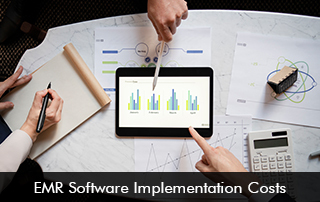Electronic Medical Records (EMR) Software solutions are robust enough to streamline daily clinical, administrative, and financial tasks. Healthcare organizations in the US have implemented EHRs not only to simplify workflows but also to enhance patient care, and boost care coordination for effective healthcare delivery.
Key Considerations Before EHR Software Implementation Cost Analysis
Healthcare organizations should carefully consider some important criteria before doing a cost analysis for the adoption of Electronic Health Records Software to guarantee a successful implementation and prevent unforeseen costs.
Here are some crucial factors to remember:
- The EMR System should fulfill specific practice requirements.
- Select the right software vendor based on the budget and long-term aims.
- Scalability should be taken into account.
- Consider third-party integrations and interoperability options for seamless exchange of patient data.
- Regulatory compliance of the EHR Software should be the top priority to comply with healthcare standards.
- Determine the ongoing costs of vendor support and software maintenance.
- Perform a return on investment (ROI) analysis to evaluate the EHR system’s potential long-term benefits.
EMR Software Implementation Costs 2023
A Health Affairs study has estimated electronic health records implementation costs of a multi-physician setup to be $162,000.
It is important to know that not all EMR Software solutions cost the same, major cost changes arise with the deployment method chosen. This can either be on-premise software or cloud-based solutions.
On-Premise VS Cloud Software Solutions
Cost analogy between the two deployment options:
On-Premise
Initial Capital Costs:
- Hardware: To host the EMR Software system locally, you’ll need to spend money on servers, storage, and networking tools. These expenses could be significant, for healthcare companies.
- Software Licenses: Perpetual software license purchases for on-premise EHR systems might have a high initial cost.
- Data Center: If your practice doesn’t already have one, you might need to create or rent one to safely house your servers.
Security and Compliance Costs with on-premise EMR Software
- To protect patient data, practices need to invest in security measures like firewalls, intrusion detection systems, and encryption.
- There will be ongoing compliance expenditures, such as HIPAA or other regulatory standards.
Cloud-Based EMR Software
Subscription Fees
- The principal expense of cloud-based EMR software is often a monthly or annual subscription charge. These payments cover access to software, hosting, and support.
Reduction in Hardware Costs
- Cloud-based solutions don’t require you to buy and maintain on-premise hardware, which can save healthcare organizations a lot of money.
Healthcare systems see cloud-based EHR software solutions as more cost-effective as well as offering the benefits of better security, flexible accessibility, and a scalable solution that can meet future growth plans.
Final Takeaway
For small practices and major healthcare organizations, the overall cost of implementing EMR software can range from tens of thousands of dollars to millions of dollars. Before beginning an electronic health records deployment, companies must undergo a thorough cost analysis and planning process to ensure that they have a clear grasp of the financial commitment required and to prevent any cost overruns. Additionally, it’s a good idea to request competitive quotes from a variety of EHR Software vendors and take into account overall expenditures rather than simply one-time fees when making a choice.






